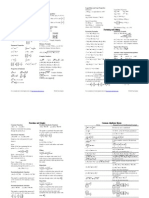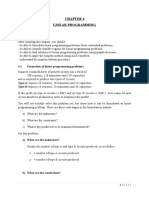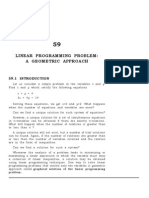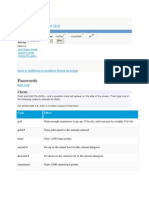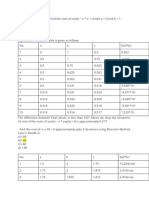Linear Programming Examples
Uploaded by
Moid Aretaño MesaLinear Programming Examples
Uploaded by
Moid Aretaño MesaLinear Programming Examples
A store has requested a manufacturer to produce pants and sports jackets.
For
materials,
the
manufacturer
has
750 m 2 of
cotton
textile
and
1,000 m 2 of polyester. Every pair of pants (1 unit) needs 1 m 2 of cotton and 2 m 2 of polyester. Every jacket needs 1.5 m 2 of cotton and 1 m 2 of polyester.
The price of the pants is fixed at $50 and the jacket, $40.
What is the number of pants and jackets that the manufacturer must give to the stores so that these items obtain a maximum sal e?
1 Choose the unknowns.
x = number of pants
y = number of jackets
2 Write the objective function .
f(x,y)= 50x + 40y
3 Write the constraints as a system of inequalities.
To write the constraints, use a table:
pants jackets available cotton polyester 1 2 1,5 1 750 1,000
x + 1.5y 750
2x+3y 1500
2x + y 1000
As the number of pants and jackets are natural numbers , there are two more constraints:
x 0
y 0
4 Find
the
set
of feasible
solutions that
graphically
represent
the constraints.
Represent the constraints graphically.
As x 0 and y 0, work in the firs t quadrant.
Represent the straight lines from their points of intersection with the axes.
Solve the inequation graphically : 2x +3y 1500, and take a point on the plane, for example (0,0).
2 0 + 3 0 1,500
Since 0 1,500 then the point (0,0) is in the half plane where the inequality is satisfied.
Similarly, solve 2x + y 1,000.
2 0 + 0 1,000
The area of intersection of the so lutions of the inequalities would be the solution to the system of inequalities, which is the set of feasible solutions.
5 Calculate
the
coordinates
of
the vertices from
the
compound
of feasible solutions .
The optimal solution, if unique, is in a vertex. These are the solutions to the systems:
2x + 3y = 1,500; x = 0
(0, 500)
2x + y = 1,000; y = 0
(500, 0)
2x + 3y =1,500; 2x + y = 1,000
(375, 250)
6 Calculate
the value of
the
objective
function
at
each
of
the
vertices to determine which of them has the maximum or minimum values. It must be taken into account the possible non -existence of a solution if the compound is not bounded.
In the objective function, place each of the vertices that were determined in the previous step .
f(x, y) = 50x + 40y
f(0, 500) = 500 + 40500 = $20,000
f(500, 0) = 50500 + 400 = $25,000
f(375, 250) = 50375 + 40250 = $28,750
Maximum
The optimum solution is to make 375 pants and 250 jackets to obtain a benefit of $28,750.
The solution is not always u nique, so we can also find other solutions. Example
If the objective function of the previous exercise had been:
f(x,y) = 20x + 30y
f(0,500) = 200 + 30 500 = $15,000
Maximum
f(500, 0) = 20500 + 300 = $10,000
f(375, 250) = 20375 + 30250 = $15,000
Maximum
In this case, all the pairs with integer solutions of the segment drawn in black would be the maximum.
f(300, 300)= 20300 + 30300 = $15,000
Maximum
You might also like
- The Art of Problem Solving Intermediate Algebra96% (25)The Art of Problem Solving Intermediate Algebra720 pages
- The Motivational Interviewing Workbook - Exercises To Decide What You Want and How To Get There100% (10)The Motivational Interviewing Workbook - Exercises To Decide What You Want and How To Get There224 pages
- Golf Strategies - Dave Pelz's Short Game Bible PDF92% (24)Golf Strategies - Dave Pelz's Short Game Bible PDF444 pages
- Catherine V Holmes - How To Draw Cool Stuff, A Drawing Guide For Teachers and Students97% (35)Catherine V Holmes - How To Draw Cool Stuff, A Drawing Guide For Teachers and Students260 pages
- [Algebra Essentials Practice Workbook with Answers Linear and Quadratic Equations Cross Multiplying and Systems of Equations Improve your Math Fluency Series] Chris McMullen - Algebra Essentials Practice Workbook with A.pdf82% (11)[Algebra Essentials Practice Workbook with Answers Linear and Quadratic Equations Cross Multiplying and Systems of Equations Improve your Math Fluency Series] Chris McMullen - Algebra Essentials Practice Workbook with A.pdf207 pages
- Math 87 Mathematics 8 - 7 Textbook An Incremental Development Stephen Hake John Saxon100% (10)Math 87 Mathematics 8 - 7 Textbook An Incremental Development Stephen Hake John Saxon696 pages
- Self-System Therapy For Depression Client Workbook100% (9)Self-System Therapy For Depression Client Workbook113 pages
- Cho o Se T He Unkno WNS.: ObjectivefunctionNo ratings yetCho o Se T He Unkno WNS.: Objectivefunction7 pages
- LPP INTRODUCTION DEFINITIONAND EXAMPLES OF Linear Programming IntroNo ratings yetLPP INTRODUCTION DEFINITIONAND EXAMPLES OF Linear Programming Intro18 pages
- Graphical Solution of Linear Programming ProblemsNo ratings yetGraphical Solution of Linear Programming Problems2 pages
- Linear Programming Is: (P Ax+by) (C Ax+by)No ratings yetLinear Programming Is: (P Ax+by) (C Ax+by)3 pages
- Module (17) - Mathematics in The Modern World100% (1)Module (17) - Mathematics in The Modern World8 pages
- Linearprogramming Problems With SolutionNo ratings yetLinearprogramming Problems With Solution8 pages
- Linear Programming Problems 2 SolutionsNo ratings yetLinear Programming Problems 2 Solutions19 pages
- 3.2a. Solving Linear Programming Problems Graphically Finite MathNo ratings yet3.2a. Solving Linear Programming Problems Graphically Finite Math30 pages
- Several Word Problems and Applications Related To Linear Programming Are Presented Along With Their Solutions and Detailed ExplanationsNo ratings yetSeveral Word Problems and Applications Related To Linear Programming Are Presented Along With Their Solutions and Detailed Explanations11 pages
- Solving Linear Programs 1.0 Basic Form: C) X (H X FNo ratings yetSolving Linear Programs 1.0 Basic Form: C) X (H X F17 pages
- Mathematics in The Modern World (Linear Programming)100% (1)Mathematics in The Modern World (Linear Programming)9 pages
- An Introduction To Linear Programming: Instructor: Dr. Mohamed MostafaNo ratings yetAn Introduction To Linear Programming: Instructor: Dr. Mohamed Mostafa46 pages
- 03 03 Linear Programming Graphic SolutionsNo ratings yet03 03 Linear Programming Graphic Solutions29 pages
- Systems of Linear Inequalities Solved ExamplesNo ratings yetSystems of Linear Inequalities Solved Examples13 pages
- Linear-Programming-Group-8 20231211 115438 0000No ratings yetLinear-Programming-Group-8 20231211 115438 000031 pages
- DAM HO PTMBA LPP Graphical With SolutionsNo ratings yetDAM HO PTMBA LPP Graphical With Solutions24 pages
- Linear Programming Chapter - 12 (Class XII)No ratings yetLinear Programming Chapter - 12 (Class XII)44 pages
- Mathematics in The Modern World: Linear Programming - Optimization ProblemsNo ratings yetMathematics in The Modern World: Linear Programming - Optimization Problems8 pages
- Factoring and Algebra - A Selection of Classic Mathematical Articles Containing Examples and Exercises on the Subject of Algebra (Mathematics Series)From EverandFactoring and Algebra - A Selection of Classic Mathematical Articles Containing Examples and Exercises on the Subject of Algebra (Mathematics Series)No ratings yet
- A Brief Introduction to MATLAB: Taken From the Book "MATLAB for Beginners: A Gentle Approach"From EverandA Brief Introduction to MATLAB: Taken From the Book "MATLAB for Beginners: A Gentle Approach"2.5/5 (2)
- Total Tractor Counterweight Produce (2014) : Required Parts For 1 Set of Tractor Counter WeightNo ratings yetTotal Tractor Counterweight Produce (2014) : Required Parts For 1 Set of Tractor Counter Weight24 pages
- Drilling, Boring, Reaming, and Tapping To Spot and Drill Work in A ChuckNo ratings yetDrilling, Boring, Reaming, and Tapping To Spot and Drill Work in A Chuck3 pages
- How To Distinguish ADHD From Typical Toddler Behavior100% (1)How To Distinguish ADHD From Typical Toddler Behavior24 pages
- Florida Teacher Certificate Examinations (FTCE) Study Guide0% (2)Florida Teacher Certificate Examinations (FTCE) Study Guide20 pages
- Optimization Techniques - Unit1 AnswersNo ratings yetOptimization Techniques - Unit1 Answers21 pages
- Statistical Arbitrage For Mid-Frequency TradingNo ratings yetStatistical Arbitrage For Mid-Frequency Trading17 pages
- CCL_leadership-challenge-ladder-technical-reportNo ratings yetCCL_leadership-challenge-ladder-technical-report42 pages
- Chapter 8 - Advanced Parallel AlgorithmsNo ratings yetChapter 8 - Advanced Parallel Algorithms56 pages
- PDF Applied Categorical and Count Data Analysis: Second Edition Wan Tang & Hua He & Xin M. Tu download100% (2)PDF Applied Categorical and Count Data Analysis: Second Edition Wan Tang & Hua He & Xin M. Tu download39 pages
- Modelling and Control of Ball-Plate System PDF100% (1)Modelling and Control of Ball-Plate System PDF22 pages
- (Big Data For Industry 4.0) K. Suganthi, R. Karthik, G. Rajesh, Peter Ho Chiung Ching - Machine Learning and Deep Learning Techniques in Wireless and Mobile Networking Systems-CRC Press (2021)No ratings yet(Big Data For Industry 4.0) K. Suganthi, R. Karthik, G. Rajesh, Peter Ho Chiung Ching - Machine Learning and Deep Learning Techniques in Wireless and Mobile Networking Systems-CRC Press (2021)285 pages
- Chapter 2 Basic Case-Based Reasoning TechniquesNo ratings yetChapter 2 Basic Case-Based Reasoning Techniques6 pages






